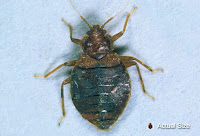
As if you needed something else to worry about, bedbugs, those pests from the old bedtime rhyme are making a comeback. More of a nuisance than a health hazard, they’re showing up to suck blood from people in hotels, college dorms, and hospitals. Take an informative look at bedbugs: what they are, where they lurk, and how to spot them before they get you.
Bedbugs are small, flat, wingless insects with six legs that, like mosquitoes, feed on blood from animals or people. They range in color from almost white to brown, but they turn rusty red after feeding. The common bedbug doesn't grow much longer than 0.2 inches (0.5 centimeters) and can be seen by the naked eye to the astute observer. Bedbugs get their name because they like to hide in bedding and mattresses.
A bedbug at actual size, and magnified for a closer look
Am I at Risk for Infestation?
Bedbugs are most often found in hotels, hostels, shelters, and apartment complexes where lots of people come and go. Because bedbugs hide in small crevices, they can hitch a ride into your home on luggage, pets, furniture, clothing, boxes, and other objects. Bedbugs are found worldwide, but are most common in developing countries. Once rare in North America, they may be on the rise due, in part, to increases in international travel.
During hotel stays, keep luggage off the floor and zipped
Feeding Habits
These nocturnal creatures can hide in beds, floors, furniture, wood, and paper trash during the day. We humans usually become their dinner during the night, with peak biting activity just before dawn.They can obtain their meal in as little as three minutes, after which they are engorged and drop off the host, then crawl into a hiding place to digest their meal. Bedbugs can live for 10 months, and can go weeks without feeding.
Bedbugs feed while you sleep, with peak biting activity just before dawn
Signs and Symptoms
Amazingly, these sneaky little bloodsuckers dine on you without waking you. You don't feel their stealthy bite because they inject a numbing agent into your body, along with an anticoagulant to keep your blood flowing as they suck. The first sign of bedbugs may be itchy, red bites on the skin, usually on the arms or shoulders. Bedbugs tend to leave straight rows of bites.
sBedbugs leave red, itchy bites on the skin, usually in rows
Treating Bites
Bedbug bites do not usually require treatment. If a secondary infection occurs (usually from scratching), apply a local antiseptic lotion or antibiotic cream or ointment. Creams with corticosteroids and oral antihistamines may be advised in the presence of allergic reaction or larger skin reactions. In these more severe cases, you may need to see your doctor.
Scratching bites can lead to infection
Do Bedbugs Transmit Diseases?
Bedbugs are more of a nuisance than a health hazard. In a recent study, researchers reviewed 53 recent studies on bedbugs and their health and medical effects. The results showed that although bedbugs have been blamed for the spread of up to 40 different human diseases, there is little evidence to suggest they are carriers of human disease.
An adult bedbug ingesting a meal from a human
Bedbug or Imposter?
Don't assume your bites are bedbugs. Bites can be hard to identify, even for doctors. Rule out mosquitoes, fleas, mites, and biting gnats by conducting a visual inspection. It's best to collect and identify bedbugs to confirm bites. Look for the bugs themselves or their bloodstains, especially along the seams of mattresses. Further, look for dark spots of insect waste where bedbugs might crawl into hiding places on furniture, walls, and floors.
Check for bedbugs along the seams of mattresses
Bite Back Against Bedbugs
Get rid of infested mattresses and box springs or cover them with a plastic mattress bag to trap the bugs. Wash clothes and bedding in hot water, and dry on high heat. Clean furniture and vacuum cracks in wood floors and doors where bugs may hide. Shake out suitcases. Use an insecticide in the cracks of floors or bed frames, but read the label; do not apply to areas that come in direct contact with skin. If you still can't get rid of them, call an exterminator.
Wash clothes and bedding in hot, soapy water to kill bedbugs and their larvae









Thanks for taking the time to discuss this, I feel strongly love and read more on this topic. If possible, such as gain knowledge, would you mind updating your blog with additional information? It is very useful for me.
BalasHapuspest control san antonio